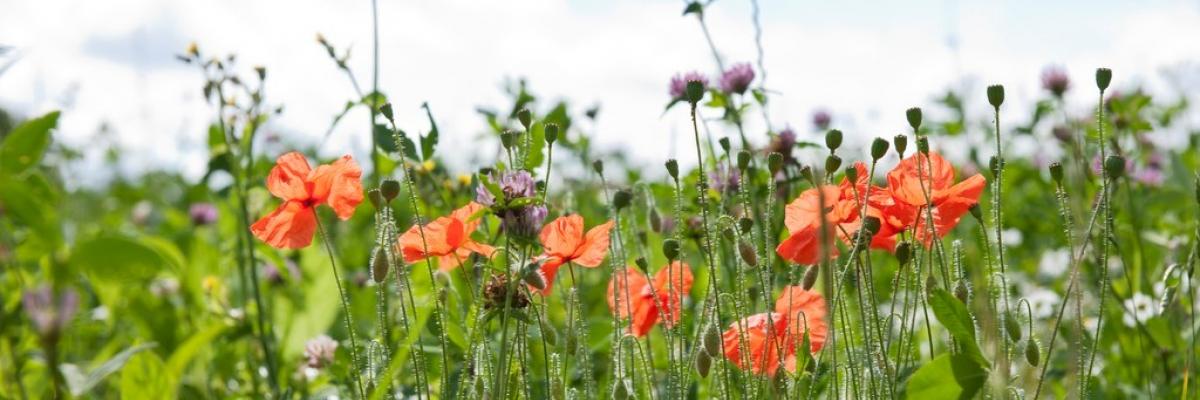
Ecological principles for weed management - steps to get you on the road to making peace with weeds
21 April 2020
For a long time, the pursuit of effective agricultural weed management tools and strategies was framed as ‘the war on weeds.’ We developed increasingly merciless mechanical and chemical weapons to rid our fields of unwanted greenery, striving toward a vision of pure crops from horizon to horizon.
These days, we’re slowly realising that war is not a helpful perspective on weed management. Sure, no one wants a field full of weeds, but not all weeds are bad, and sometimes the actions we take to get rid of them do more harm than good. That’s harm to both our farms and to our surrounding environment. Furthermore, weeds are proving to be irrepressible opponents; if they don’t like what is thrown at them, they quickly adapt, or a more tolerant species subs in from the sidelines. Making peace with the weeds will cost us less in the long run than trying to eradicate weeds from the fields.
The benefits of learning to live with weeds are illustrated by some recent studies showing that crop yield loss declines as weed diversity increases, and that retaining some weed cover can support beneficial insects as well as farmland birds. Perhaps most interesting is a study from France showing that some groups of weeds - typically diverse, and typically composed of small, low-growing species - have no detectable effect on crop yield at all, even when no weed management actions are taken.1 This, rather than weed-free fields, should be our goal.
How do we get there?
Managing weeds for net benefits rather than costs requires an understanding of why different numbers and types of weeds occur in different places, and what can be done to influence that. What, for example, led to the diverse, low-growing weeds occurring in the French study, and how can farmers obtain similar weeds in their own fields?
Current weed science is beginning to answer this question through exploring the ecological relationships between weeds and their environment (disturbance and nutrients) and other organisms (crops, livestock, and wildlife). In this blog, I would like to share some simple principles arising from the study of weed ecology that farmers can look to implement on their farms. These principles should help to reduce the likelihood of problematic weed outbreaks, whilst promoting beneficial weed diversity.
Implementing each principle of ecological weed management should be done with the strategies and tools most suitable to everyone’s own farming system. They can fit conventional, organic or no-till systems, arable or perennial crops or livestock - although how you do it may be very different in each system. I have also shared a few practical ideas of how these principles can be put into practice, although the suggestions are by no means comprehensive (weed scientists have more work to do here, and many farmers may have better ideas about it than we do!).
A key point about following these principles is that they should not be extra work done simply for the sake of weeds. All could also be recommended for managing pathogens and insect pests, contributing to soil health, increasing resource use efficiency and improving yield stability.
Think of weeds as a reminder to manage the farm in a resilient, sustainable manner. Weeds keep us in check as we keep them in check; the more monocultures we farm, the more fertilisers we apply, the more we disturb the soil, and the more chemical tricks we use, the more weeds get out of hand in the long run. If we keep these things to the absolute minimum that we need to support crop or animal growth, then weeds will slowly become more manageable, and possibly even beneficial.
Increase diversity in all its forms
Crop rotation, crop mosaics, crop mixes, intercrops, forage mixes, integrated crop-livestock systems, organic matter sources, nutrient sources, hedgerows, margins, trees, wildlife, microbes. All these are avenues for farm diversification that help to limit weed numbers and to promote weed diversity, by varying conditions in space and time across the farm and landscape, and promoting the natural enemies of weeds. Diversification ensures that no weed species encounters uninterrupted favourable conditions that would allow its population to continuously grow. It also helps to sustain weed diversity, by reducing the chances that some species encounter consistently unfavourable conditions and are lost (think of cornflowers).
Diversification in farm practices can also reduce selection for weeds that behave like crops. The best way for a weed to survive a rigorous management regime is to mimic the crop: germinate with the crop to avoid tillage, tolerate the same herbicide regime as the crop, utilise the fertilisers applied to the crop. This means that the most competitive weeds - the ones that want the same resources at the same time as the crop - are most likely to survive intensive control. If the same crop is grown consistently, its weed mimics will thrive (think of blackgrass in winter wheat).
‘Little hammers’ not ‘sledgehammers’
The phrase ‘many little hammers’ has long been used to encourage diverse weed management practices, and it is increasingly apparent that those hammers must indeed be ‘many’ and ‘little.’ Really big hammers, such as using every herbicide and tillage tool you can get your hands on all in the same season, get rid of most weed species but can select for specific strategies that a few weeds use to avoid all of these. For this reason, variable germination times, fast growth rates and herbicide cross-resistance underpin many of the most problematic weeds worldwide. Instead try to rotate tactics between years rather than using everything at once.*
‘Little hammers’ can also be used to shift weeds to more desirable types, by disadvantaging the weeds you don’t want. For example, taller weeds tend to be more competitive, so tactics that kill tall weeds but allow short weeds to survive can promote a less competitive weed community - mowing, topping or weed wipers might be appropriate, depending on the farm type.
*NB: to delay or avoid resistance to herbicides, the evidence so far suggests that using mixes of herbicides each year is better than rotating single herbicides between years, but rotating different mixes of different herbicides is better, and using non-chemical tools in rotation with herbicide mixes is best.
Reduce resource availability
Weeds will grow wherever there is enough nutrients, light and moisture, so try to reduce these opportunities. Competitive crops are a good way to capture resources and keep them away from weeds - choose competitive cultivars, sow as densely as appropriate, and consider intercrops or crop mixes. Combinations of crops with different growing times and growth forms can more effectively utilise available resources than single crops.
Minimise fertiliser applications, and where possible, use slow-release fertilisers (green manures and composted animal manures are a good example). This avoids a big flush of nutrients being available to weeds before the crops can make use of the nutrients. High resource availability also promotes types of weeds that grow quickly - their life strategy is to grab as many resources as fast as possible before anything else (like the crop) does, and this makes them more competitive. In contrast, low resource levels select for weeds that grow more conservatively and impose less intense competition.
Take advantage of the positive effects of weeds
Weeds help to support natural enemies such as lacewings, ladybirds and beetles that eat aphids and other pests. Some weeds also taste better to pests than crops, and help to distract the herbivores. Weed flowers and seeds, as well as the bees, the birds and the butterflies they support are all needed for wider ecosystem health. Weeds can help to shelter the soil from the weather, while leguminous weeds can provide free nitrogen and the long taproots of weeds like dock can bring nutrients up to the surface that will be available when the plant decomposes. Managing for a diverse weed community is the best way to maximise benefits while minimising competition with crops.
Of course weed control will always be necessary to some extent, but in some situations, the cost of the weed control (in terms of money spent, fuel used, soil disturbed and ecosystem function lost) may be greater than the cost of the weeds. The more we learn about weeds, the better we will be able to judge this, improving our capacity to maximise farm productivity and profitability whilst sustaining a healthy environment.
Chloe MacLaren is an ecologist at Rothamsted Research exploring how we can design resilient, sustainable cropping systems. Her PhD focused specifically on weed management, but now she works more generally on how different crops and management practices can be combined to maximise both productivity and environmental benefits. Chloe splits her time between the UK and sub-Saharan Africa.
More information and practical examples of putting these principles into practice can be found in other Agricology blogs and resources (see 'Related content)
1Adeux G, Vieren E, Carlesi S, et al (2019) Mitigating crop yield losses through weed diversity. Nat Sustain 2:1018–1026.
Header image © Rothamsted Research


